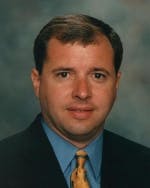For more on this topic, go to www.dentaleconomics.com and search using the following key words: CBCT, field of view systems, ALARA principle, Dr. Jeffrey Brooks, Dr. David Gane.
3-D cone beam computed tomography (CBCT) technology has been on the market for more than a decade, and is rapidly evolving with the changing needs of the market. We are definitely seeing a trend away from dedicated larger field of view (FOV) systems in favor of smaller FOV CBCT systems that also incorporate digital 2-D panoramic and cephalometric capabilities. I recently had the opportunity to discuss this with my friend and coworker, Dr. Jeffrey Brooks, whose interesting career path, experience, and unique knowledge make him an authority on this subject.
Dr. Gane: Jeff, you are enjoying an interesting and remarkably diverse career as an oral surgeon and key contributor in the development of groundbreaking new 3-D imaging technologies. That’s an uncommon mix. How did you become so interested in computerized imaging technologies and their application to dentistry?
Dr. Brooks: I have always been amazed with medical and dental technology and truly fascinated at how embracing technologies can optimize surgical planning and improve treatment outcomes. Nine years ago our practice implemented its first CBCT system. We immediately realized that we had filled a giant gap in our imaging capability. Being able to visualize the patient in this new way, with such anatomical accuracy and certainty, left me wanting to assist others in appreciating what this powerful new technology could do. After using this technology only a few times, it became apparent that CBCT would be embraced by dentistry in a big way, and there would be a need to refine and improve the systems to better meet the needs of the profession. It was this challenge that kept me so excited about CBCT since the day I acquired my first 3-D scan.
Dr. Gane: Before joining the Carestream team, you contributed to several dental technology companies. Share with me how your technology career evolved, and why you settled at Carestream.
Dr. Brooks: I started my technology career early in college and continued it through dental school and my oral surgery residency. I started a company that provided turnkey digital solutions for dental offices while maintaining a private practice in oral and maxillofacial surgery. I learned much there, and it gave me a unique perspective. I have also worked with a number of CBCT companies in varying capacities. I moved to Carestream about two years ago as the director of clinical affairs. I was immediately impressed with the direction that Carestream was taking with CBCT products. The company was specifically aligning R&D with customer needs. Carestream learned early that to be a market leader, its CBCT systems had to be multimodal and easily adaptable to the clinical situation at hand. In discussions with you and other business leaders of Carestream, it was refreshing to hear the vision and see the commitment to 3-D dental imaging. The philosophy was to develop easy-to-use extraoral imaging solutions that would give the clinician the diagnostic imaging information to approach patient diagnosis and treatment with confidence.
Dr. Gane: What did you see as the main benefits and limitations of some of the earlier CBCT systems, and how have they improved during the last decade?
Dr. Brooks: Indeed, we have witnessed a fast evolution of CBCT in a short period. The trend now is toward better, faster, smaller, and easier-to-use systems. We see far fewer dedicated CBCTs and a greater adoption of systems with greater 3-D field of view options that incorporate 2-D modalities, such as pan and ceph with 3-D. As our understanding of the 3-D imaging needs of the clinician grows, we are better able to engineer and build systems to meet these needs. Selectable fields of view, faster scan times, dose reduction, higher resolutions, faster reconstruction times, improved image quality … these are all moves in the right direction. Better and easier-to-use visualization software is also a definite and welcomed trend.
Dr. Gane: I know that much of your time lately has been spent on the recent launch of the CS 9300-1 CBCT system. What makes this system different?
Dr. Brooks: The 9300 is designed by clinicians for clinicians. This unit incorporates the aforementioned advantages that clinicians need in a multimodal extraoral imaging system. It has seven fields of view ranging from 5x5 cm to 17x3.5 cm. This provides the scalability needed to quickly acquire a 3-D image specific to the region of interest and reduces unnecessary radiation exposure to the patient. High scan resolutions of 90-micron voxels gives excellent detail when evaluating fine anatomical structures such as root canal anatomy, PDL space, etc. The multimodality nature of this system allows it to function as a 2-D digital panoramic imaging system with variable focal trough. Of course, it’s a fully functional CBCT system as well. An optional cephalometric modality will also be available soon.
Dr. Gane: What was the motivation to design a CBCT system with 2-D pano technology and multiple FOV options?
Dr. Brooks: The panoramic image is a great low-dose screening image and is widely used in the profession, especially in surgical practice. Office space can sometimes be an issue, and clearly having a system that incorporates 2-D and 3-D functionality in one compact unit is beneficial to workflow. Having an all-in-one unit that allows the staff to become proficient with a system that does everything is a big plus, too. Finally, maintaining digital images in one database location and using one imaging software program for 2-D and 3-D acquisition and visualization can be a huge benefit to clinic workflow.
Dr. Gane: As you see them, what are the main advantages of having a range of selectable FOVs?
Dr. Brooks:The main advantage of selectable FOVs is that we can “dial in” the optimum volume size for the task at hand. Selecting the appropriate volume size allows us to control dose so we can strictly adhere to the ALARA (As Low As Reasonably Achievable) principle. It also reduces our professional responsibility to read and report the data findings due to the usually smaller volume sizes selected. As clinicians, we clearly have a responsibility to diagnose and render treatment with proficiency and to the best of our ability. This includes obtaining the appropriate size images to support clinical decision making.
Dr. Gane: Image quality in 3-D imaging is always important and especially critical in certain applications such as endodontics. Are there any additional image quality innovations on the CS 9300-1? Is the CS 9300-1’s resolution high enough for endodontic purposes?
Dr. Brooks: Image quality in the CBCT world is comprised of many factors. The CS 9300-1 has several new technical advances that allow the clinician to optimize image quality. When high resolution is required for a particular task, such as endodontic evaluation, the 9300 allows control of this by selecting different scan times and appropriate resolutions prior to image reconstruction. Again, this puts the control in the hands of the clinician to offer the flexibility needed to optimize the image to the specific clinical situation.
Dr. Gane: For which market segment was the CS 9300-1 designed?
Dr. Brooks: With the 2-D and 3-D modalities combined in one unit, the CS 9300-1 was designed to work well in all dental applications and is appropriate for all specialties. Because the operator can select CBCT FOV and dose, and/or take a panoramic or “one-shot” digital cephalometric image, all extraoral imaging needs are covered.
Dr. Gane: It seems the CS 9300-1 would work well in a multi-specialty group practice. Was the design consideration to appeal to such a large market segment on purpose?
Dr. Brooks: Indeed it was. The input for this design came from general dentists, as well as all specialties of dentistry. The phenomenal feedback from the different departments at the University of Tennessee School of Dentistry is a testament that the translation of these design principles to the production unit was a true success.
Dr. Gane: The release of the CS 9300-1 was accompanied with a new 3-D software version. What’s new in this software version?
Dr. Brooks: We have committed to an ongoing developmental process for our 3-D software. This latest version has a new look and many new functional enhancements. Our 3-D customers let us know what they wanted, and we listened. Some of the highlights in this version include a new look and user interface, advanced implant planning tools, a new TMJ analysis module, and a number of new export, sharing, and reporting options. Carestream customers using the K9000 and the K9500 CBCT will also receive this update in the near future.
Dr. Gane: In your estimation, will CBCT ever completely replace 2-D dental radiography?
Dr. Brooks: Certainly, you can never rule out what future technology will deliver. I do look at medical colleagues who have had 3-D imaging available to them for more than 30 years, and we still see the use of 2-D imaging. I think there will be indications for 2-D imaging in the dental practice for a long time. CBCT is not the gold standard for everything. A prime example is that caries detection is still best investigated with digital 2-D bitewing images. We must use CBCT selectively as an adjunct to 2-D images when 2-D images are not sufficient for the task at hand. CBCT will not completely replace 2-D dental radiography anytime soon.
Dr. Gane: There seems to be a strong need for CBCT education. Do you have any advice on how others can learn more about CBCT technology and best practices for its appropriate use?
Dr. Brooks: There are a number of resources online. You can visit www.aaomr.org or www.marcilan.com for good information. I also like Dr. David MacDonald’s book “Oral and Maxillofacial Radiology,” published by Wiley-Blackwell. In addition, Carestream will be host to its annual 3-D symposium Nov. 4-5 in Atlanta.
Jeffrey Brooks, DMD, is a board certified oral and maxillofacial surgeon and maintains a position as assistant professor in the Department of Oral and Maxillofacial Surgery at the University of Tennessee-Memphis. Dr. Brooks holds the position of clinical director for Carestream Dental. Reach him at [email protected].
Dr. David Gane has a passion for dental imaging and has published and lectured nationally and internationally on the topic. Dr. Gane serves as vice president of Dental Imaging for Carestream Dental LLC, the exclusive maker of Kodak Dental Systems. Reach him at [email protected].







